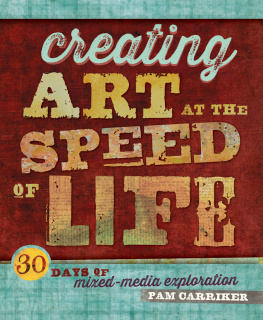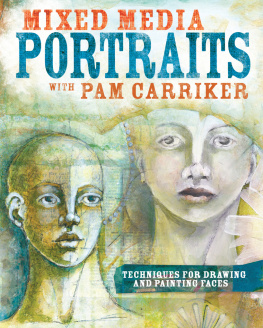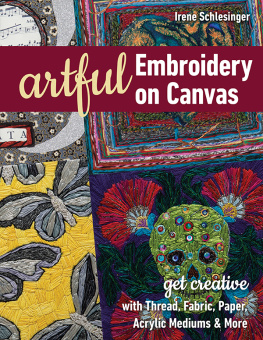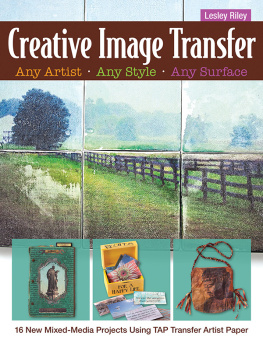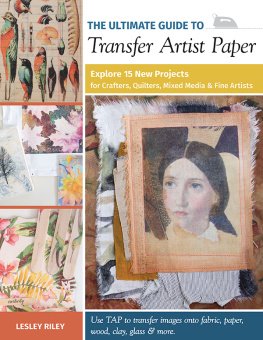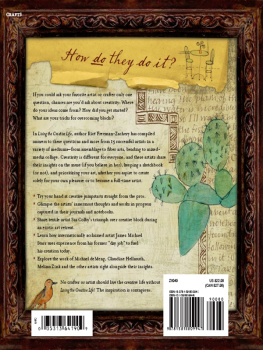CREATING
ART AT THE
SPEED
OF LIFE
30 DAYS OF
mixed-media exploration
PAM CARRIKER

INTRODUCTION
Driven to Create
My first book, Art at the Speed of Life, was about finding time to create art. Even before Id met the deadline for that book, I began to jot down notes for a second book. The more immersed in being creative I became, the more inspiration bubbled out! There was just so much more I wanted to share about the process of actually making art. Im a doer: its not enough just to have a great idea; I have to actually roll up my sleeves, get my hands dirty, and go to work.
GETTING REVVED UP
Creation is the act of producing or causing something to exist. Finding the time to create art is a very important first step, like starting your cars engine and putting it into gear, but once you decide to make room for creativity in your life, its time to step on the gas pedal and get going! In this book youll find thirty exercisesa whole months worth of journaling techniquesgeared toward the fundamental elements of creating and assessing art. Its important to be able to assess your artwork in order to move forward and continually grow and become confident as an artist. This does not mean you need to create perfect art, but rather to have an inner discussion about what does or doesnt work in the art you create. Color, texture, shape, space, form, line, and value are the road signs marking the way as you navigate the world of mixed-media art.
ROAD TRIP
Youll use a handmade journal large enough to hold all thirty exercises as your vehicle on this journey, leaving behind the expectation of creating perfect art and instead concentrating on the creative process. Focusing on the product rather than the process can leave you frustrated and discouraged, much like having a flat tire. With a good map, the right frame of mind, and the necessary tools, you wont ever be caught stranded again. The journal you create will become a valuable reference tool to use in the future; a road map of sorts for those days when you may feel youve lost your way or just need to jump-start your muse and begin Creating Art at the Speed of Life.
HOW TO USE THIS BOOK
Over and over again, students in my workshops ask for an honest evaluation of their work. They want to know what they could do differently to make it better. Assessing your own work is something that can be learned and is an invaluable tool to move yourself further down your creative path. The thirty lessons in this book are grouped into chapters that each focus on a different element of art. Working in a handmade art journal will encourage you to experiment and find what makes Art happen, and youll end your journey with a completed journal, a useful tool to refer back to again and again. This journal will be the perfect place to fearlessly explore the elements of art in a structured way and practice various mixed-media techniques, all while learning what makes your art visually pleasing.
The lessons are laid out in true workshop fashion, with a syllabus (Quick Look) giving an overview of each chapter, objectives for each journal exercise, illustrated instructions to help you tackle each exercise, and a space for self-reflection and self-assessment of your work.
At the end of each chapter, there is an Open Studio section where you can see artwork from a variety of artists and find out how they assess their work. Its like standing behind artists in a gallery, eavesdropping on what theyre saying about their own art and what makes that particular piece work for them. Included in each Open Studio is a Q&A with the contributing artists as they weigh in on a topic related to the chapter.
Striving to grow more accomplished in art is part of what drives you to keep creating, and becoming adept at evaluating your own work is what propels you forward. By working in your own journal and using the self-assessment tools as part of your journaling process, youll learn some new techniques and end up with valuable information about your own work, adding some important building blocks to your artistic foundation.
ASSESSING YOUR WORK
The blank template shown below can be photocopied and filled in for each chapters lessons. Adhere it to a page in your journal to keep a record of your progress and findings. For the first few lessons (except Lessons 1 and 2, which are tools that dont need to be assessed), I included thoughts on my own pages to give you an idea of the kinds of things to think about with your work. Later in the book, some of the assessment worksheets are intentionally left blank, freeing you to make your own findings. (For some of the lessons, both pages of the spread are filled with artwork. In those cases, you can tuck your self-assessment page into the journal or keep it in a separate journal.)

Download a copy of the assessment worksheet here.

the Handmade JOURNAL
This journal will hold all of the exercises in this book. Youll have space for a two-page spread for eachone page for the lesson and one for assessing your workwith the exception of Lessons 1 and 2, which will be the first two pages of your journal and are tools themselves that wont need assessing.
SUPPLIES
Two sheets of watercolor paper, 22" 30" (56 76 cm) each
Bone folder
Awl
Upholstery needle
Waxed linen thread
Bookbinding tape or other cloth tape
One 12" 12" (30.5 30.5 cm) sheet of Sticky-Back Canvas (Claudine Hellmuth Studio brand)
- Fold one 22" 30" (56 76 cm) sheet of watercolor paper in half widthwise and score with the bone folder. Tear the paper on the fold.
- Fold each of the two 22" 15" (56 38 cm) horizontal pieces in half widthwise, score, and tear on the folds.
- Fold each of the four 11" 15" (28 38 cm) horizontal pieces in half widthwise, score, and tear on the folds.
- Fold each of the 712" 11" (19 28 cm) pieces in half widthwise and score. Do not tear. These are your folios. Repeat Steps 1 through 4 with the second sheet of watercolor paper.
- Open three folios and stack them together to form a signature. With the awl, punch holes in the fold in three places: 1" (2.5 cm) from the top, in the center, and 1" (2.5 cm) from the bottom. Do this to make five signatures (with one folio left unused).
tips
- Instead of Sticky-Back Canvas, you can use plain canvas from a pad the same way, and then use spray adhesive or other glue to adhere it.
- Instead of painting the Sticky-Back Canvas, you can run it through an inkjet printer to create your cover.
- Thread the upholstery needle with a length of waxed linen thread that is roughly twice the length of the open book, or about 22" (56 cm).
- Run the thread through the middle hole on the inside of the journal, leaving a 2"3" (57.5 cm) tail. Go through the bottom hole on the outside, run the thread back up the inside of the signature, and go through the top hole on the inside of the journal. Go through the middle hole on the outside and tie the two tails together over the inside long stitch

